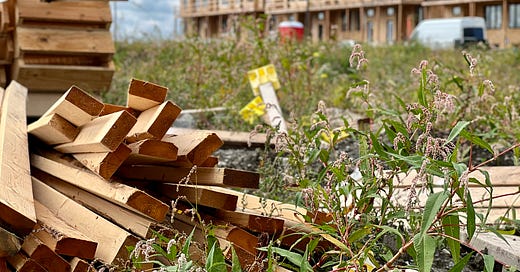Fix Housing 3: Three Things Your City Needs to Do to Get Housing Built
The most important municipal reforms to get housing built that meets everyone's needs
This is the third in a series of common sense solutions for achieving housing affordability for all.
Cities need to be on board
Housing is a shared responsibility of all levels of government.
But there is a unique role for municipalities. Municipalities decide what gets built, and how quickly it happens. Provinces can legislative municipal reform, but cities have a remarkable ability to slow down or stymie reform if they so choose.
We can’t solve housing in Canada without cities being fully on board.
To get housing built, there is a lot that cities need to do. Here are three key ways in which we need cities to step up.
1. Fix zoning
Much of the land in our cities is zoned for single family detached housing. It’s long overdue for this to be replaced with zoning that creates missing middle housing (i.e., townhouses, small apartment buildings and anything else between a single family home and a high-rise tower).
Our friend and housing expert Carolyn Whitzman sums up the residential zoning we need as follows:
Allow up to 4 story dwellings on a single lot, or 6 stories for affordable housing,
Allow up to 8 story dwellings within 400m of a bus route, or 12 stories for affordable units,
Allow up to a 20 story dwellings near mass transit stations, or 30 stories for affordable units,
Put no limits on the number of units or floor space area,
Require no minimum parking, and
Reduce setbacks and design elements that increase costs and curtail accessibility and energy efficiency.
All of this would be “as of right” – meaning that if a project meets zoning regulations, city officials cannot overrule it based on neighbourhood character or other considerations.
Portland, Oregon has done much of this, passing some of the best zoning reforms in North America in 2020. They have “legalized missing middle” housing, as described in the Sightline Institute’s infographic below:
2. Make surplus lands available for affordable housing
Cities have policies for disposing of surplus lands. These policies should be overhauled to prioritize housing, and affordable housing in particular.
Non-profit builders can reduce their per unit costs by almost half if they are able to access low-cost leased land. Much of the surplus lands in municipalities is at or near rapid transit. These parcels should be offered up first to non-profit housing providers, before being considered for other uses.
3. Lower the soft costs of building
Residential construction involves both hard costs (land and construction) and soft costs (designs, permits, development charges, sales and taxes). With high interest rates, many projects are not starting as financing makes them cost-prohibitive. Governments at all levels can look at foregoing certain soft costs, to help make projects financially viable.
Municipalities could forgo development charges, but with city budgets as strained as they are, that’s a tough sell. If cities are going to reduce soft costs, it’s up to the provinces to foot the bill and compensate cities for lost revenues.
Provincial support is especially important when few people really understand how much profit developers are making — and whether cost savings would get passed on to buyers. Lowering soft costs should go hand-in-hand with a process to provide greater transparency around the financials of home building.
Reform is not easy
These three municipal actions will help get housing built.
The only problem is that these reforms are tough for cities.
New zoning will be fought tooth and nail by many existing homeowners who resist change. Zoning reform can be mandated by provinces, but few have shown the courage to do what needs to be done.
On finances, city budgets are already at breaking point.
Cities will need some serious incentives to make the required reforms.
Enter the feds …
Here is where we think there is a unique opportunity for the federal government. We’ll talk about this in Fix Housing 4. Keep an eye out for our next message.







